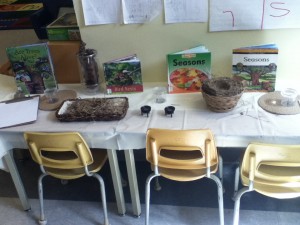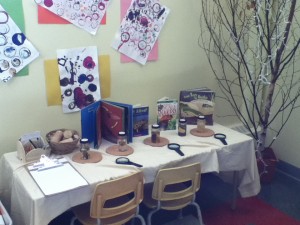 We are currently working on growth and change as an inquiry focus. I have selected materials that we have found in nature as well as some science items like worms, frogs, chicken embryos, and grasshoppers for the children to examine. We have studied some of them using our KWL chart—becoming researchers and looking in books, and on the internet to answer our “I wonder” questions. Through this learning process, children have been exposed to several types of non-fiction books (we compared fiction and non-fiction), learned how to journal their observations with adult support, and have drawn diagrams with labels. The materials are left for them to explore during our learning block of play. As children explore I will often place myself into the space to hear their conversations, to encourage them to record what they see, and to ask open-ended questions about their thoughts or to extend their learning. Next we will be adding our Butterflies to the collection!
We are currently working on growth and change as an inquiry focus. I have selected materials that we have found in nature as well as some science items like worms, frogs, chicken embryos, and grasshoppers for the children to examine. We have studied some of them using our KWL chart—becoming researchers and looking in books, and on the internet to answer our “I wonder” questions. Through this learning process, children have been exposed to several types of non-fiction books (we compared fiction and non-fiction), learned how to journal their observations with adult support, and have drawn diagrams with labels. The materials are left for them to explore during our learning block of play. As children explore I will often place myself into the space to hear their conversations, to encourage them to record what they see, and to ask open-ended questions about their thoughts or to extend their learning. Next we will be adding our Butterflies to the collection!
Over the last while I have engaged in some professional reading around the Reggio classroom. Some of the main ideas is to encourage independent learning, bringing nature and calmness into the environment, and focusing on inquiry in multiple areas of the room.
Creating an environment that will encourage investigation and inspire your students to be researchers begins with displaying materials that children can touch, triggers their interest (possibly with some discussions in large group), and placing items that are reflective (like mirrors) and the use of light in different ways (light tables, overhead projectors, lamps, wall of lights).
Once we engage the learner we can begin listen to the conversations, ask questions and begin researching.
As children explore, educators can begin the documentation process. Below are a variety of pictures that display centre ideas that can be incorporated into the classroom. Items are displayed in a way that will attract attention, use different surfaces to change the dimension of the classroom, and will certainly lead into questioning.
Here there are 3 activities. One is the 3 glass containers with items in them and containers below. Students see this and it may lead to sorting. The second display is highlighters with coloured paper which may encourage some reluctant writers to experiment with colours and see the variety of paper too! Next is the overhead projector with bottles of coloured water and different materials inside plastic water bottles. Children can display them on the wall, in the block centre or elsewhere in the room. This can lead to an inquiry on light, colour, shapes etc.
This s a creative way to display materials and let children decide how to use the display.
Here are some natural materials found in the environment that can be displayed at a table in a science area. The materials are neatly organized to invite the students to explore. You can add paper and pencils to allow the children to draw what they see and this can spark an inquiry about nature-trees, rocks etc. You can talk about diagrams and bring in some non-fiction books about the topic that can be displayed along side the table.
Another idea to display rocks, gems, found materials onto a lazy susan. This activity can be tied into math for sorting, graphing, counting, 1 to 1. Or an abstract art glueless mosaic activity can come from this. To the centre you can again add paper to allow the children to draw their creations and display them. You may begin an inquiry into colour…..
Strategically placing materials in the room that are neatly displayed will engage the learner into perhaps trying new things and asking questions which can lead to many inquiry projects and meet many curriculum expectations.
As we get to know our students and document their learning, you will discover that every child will learn at their own pace. In the Kindergarten program there is ample opportunity to differentiate instruction for children throughout the various centres and they can begin where they are comfortable.
An example of differentiating instruction that was supportive in strengthening skills in literacy was to use visuals. When I chose my read aloud for the week, I ensured that when we discussed “characters”(for example) I had copied pictures either photocopied or in colour, I also included a drama piece when we focused on retelling the story. When it came time to work one-on-one to test comprehension, I often used the pictures of the characters to help them. Another idea that I also used was to photocopy 5 main parts of the story and have the children assemble it in order and orally tell me what they remembered from the story.
In looking at the environment of the classroom, surely posting up student work to display what they have learned makes them feel valued. Posting pictures of the students while completing various tasks, displaying learning charts/anchor charts from the inquiry process with children’s names next to their ideas, and having clear learning goals discussed and displayed in the centres helps guide learning in the classroom. It also displays to parents what the children are learning. The entire classroom environment sets the tone for learning and really shows what is valued and important. In our school we have implemented a program called First Steps. We talk about setting rules for circle time through simple songs, being respectful, and we centre on student strengths. Attached is a great checklist to reflect on your classroom and school environment http://earlylearningcentral.ca/wp-content/uploads/2009/02/R-of-M-grade-1-creating-the-whole-school-learning-environemnt.pdf . Reflecting the culture of your students into the classroom also provides a great learning point. Since most of my students are from an aboriginal background we discuss the medicine wheel and how it ties into nature. I have framed pictures of the students dancing in powwows, books and artifacts are displayed around the room. Reading resources have been easily integrated into my reading program. The use of visuals (pictures, book, artifacts) have been introduced in my oral language groups as a starting point for discussions.
If children have special needs, an IEP is a place where you would need to document specific learning instruction (accommodations) that will best meet the students learning goals. In Kindergarten, it starts with clear goals, visuals, and oral discussion for them to be successful.
Thinking it Through and Primarily Play have some great ideas on how to prepare your learning environment for this September. As I prepared for my students last September in a newly renovated space, it was difficult to picture how the room should look. Not only did I need to select suitable furniture that was purposeful, but create spaces where students could gather and engage in various centres. What I also needed to consider was that my students eat snack and lunch in my classroom so I needed to have enough furniture for that as well. The furniture had multiple purposes!
Over several days and several discussion with my ECE partner, we moved furniture and carpets into different work areas. As centres do change throughout the year, for the beginning we had set-up the House centre, a Block centre, a Science centre, the main carpet area with a shelf of various toys like Lego, small foam and wooden blocks, cars and ramps etc., an Art centre, Music centre, Math centre and a reading shelf (which we later changed and are continuing to change!). We kept the materials to a minimal for the first few weeks of school so we could practice with our students rules and routines, and slowly add as we learning more about them. Items within the centres had purpose and were organized to engage the students in their new environment.
Next we worked on clutter! Whatever we did not need we found a storage place elsewhere in the building and we talked both to the principal and janitor to find the space. Between the two Kindergarten classrooms we worked together on sharing equipment and toys. Keep in mind this is not an easy task to complete in one day and you for sure will make changes as you see fit throughout the school year.



Recent Comments